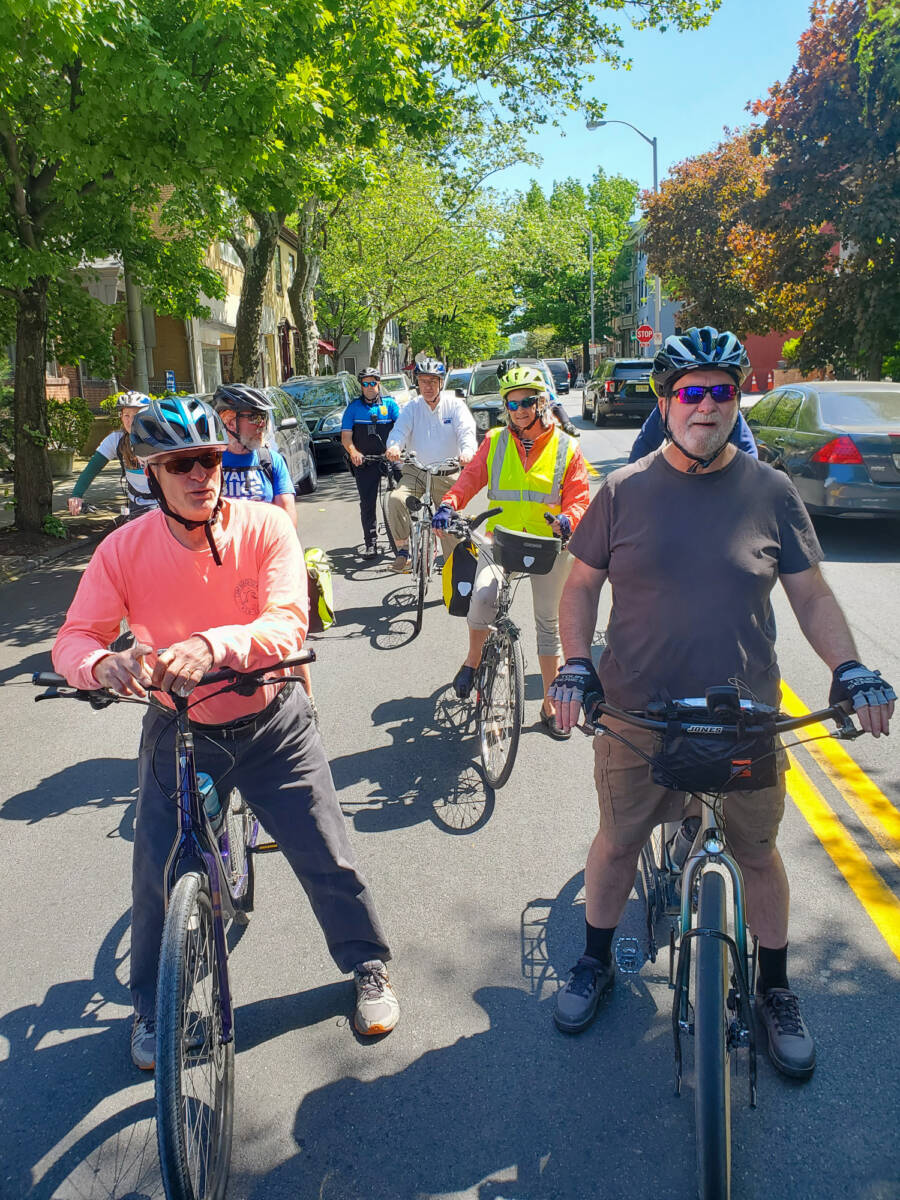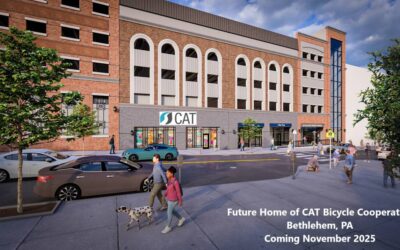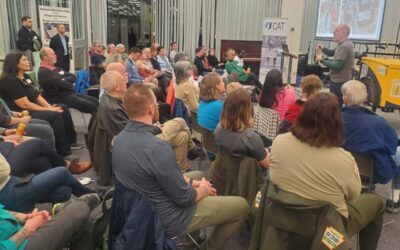A version of this article was originally published on February 4, 2024 in the Morning Call.
Your View: West Broad Street’s bike lanes would make it safer for pedestrians, cyclists
We are writing on behalf of CAT to voice enthusiastic support for the City of Bethlehem’s West Broad Street separated bike lane project. Separated bike lanes have the potential to be transformative for the city and will offer big benefits to the community if they are implemented responsibly. Every detail matters for success.
For readers new to the lingo of urban bicycling infrastructure, know that there are many kinds of bike lanes, to deal with many kinds of traffic and road conditions, only one being separated bike lanes. As defined by the Federal Highway Administration, a separated bike lane is “…an exclusive facility for bicyclists that is located within or directly adjacent to the roadway and that is physically separated from motor vehicle traffic with a vertical element.” In many cases, this involves locating separated bike lanes between parked cars and the sidewalk.
Over the last 10-15 years, separated bike lanes have become ubiquitous in cities around the U.S. and globally. As the public support for separated bike lanes grows, it is clear that CAT’s dual role is (1) to educate & inform bicyclists and motorists about new ways of driving related to separated bike lanes, and (2) to encourage implementation of smart designs that make separated bike lanes as effective as possible.
There are big reasons to implement separated bike lanes on West Broad Street. From a safety perspective, the street is too wide, encouraging motorists to drive too fast, and pedestrians have too far of a crossing distance. Separated bike lanes will transform Broad Street into the spine of a city that prizes humanity over highways.
The primary benefit of West Broad Street’s separated bike lanes is traffic calming that slows speeding motorists down where it matters, in the heart of the city where people live, walk, and bike. Studies show that pedestrian safety drastically improves when drivers travel 25mph versus 35-45mph.
A second major benefit is that separated bike lanes and curb extensions will shorten pedestrian crossing distances by more than half. This covers more than 20 intersections along a 2-mile corridor, in direct proximity to five schools and 20,000 residents. To boot, incorporating LANTA Enhanced Bus Service bus stops and shelters into curb extensions, will avoid buses having to cross the bike lanes to stop.
A third benefit of separated bike lanes over conventional bike lanes is that by moving street parking away from the sidewalk, cars and delivery vehicles will not cross the bike lane to park, and by including a door zone buffer, motor vehicles will not risk opening a door into the bike lane. It also provides a calmer environment for pedestrians and local businesses.
Every detail matters for implementation: Designers need to provide enough visibility between motorists and cyclists on the approach to every intersection and driveway. The designs of Broad Street’s bike lanes are not yet available, but we at CAT urge designers to offer ample sight distance for safety of bicyclists travelling at 20mph, the maximum legal speed for e-bikes in PA, a speed that can also be reached by bicyclists without motors in many cases. Turning motorists will need to look in the bike lane before turning and yield to bicyclists who are travelling straight. A bicyclist travelling at 20mph will appear quickly, especially to a driver slowing down to make a turn. Signage & traffic signals can encourage drivers to avoid conflicts. Other design considerations will determine success, such as: provisions for bicyclists to make left turns, drainage, surface maintenance, and sweeping in all seasons.
The timing for bike lane implementation on West Broad Street comes at a time when national and state professional design standards are being refined based on real world experience. The new revisions of these standards will include intersection sight distance guidance for the first time – something that CAT’s team has been discussing for 10+ years.
Bike lane designs are evolving. New York City has 1,525 miles of bike lanes (644 miles protected). In Philadelphia, over the last 20 years, 340 miles of bikes lanes (25 miles of protected bike lanes) have been installed, and in that time the city has documented a 46% increase in bicycle ridership. CAT’s review of publicly available crash data from PennDOT has shown that even in this era of smart phones and distracted driving that Philadelphia’s total bicycle crash rate decreased by 61%, while fatal/serious injury bicycle crashes decreased by 14%.
Separated bike lanes are not going away. As cities and boroughs embrace them, they are becoming an integral part of roadway design around the United States. Nationally, bike lanes are prevalent in numerous cities.
West Broad Street is the spine of Bethlehem’s west side. From a health and economic perspective, incorporating separated bike lanes furthers Bethlehem’s goals to be a vibrant, livable, and climate-resilient community.
Bethlehem and other Lehigh Valley municipalities should not settle for less than the best street designs, and CAT will use our collective voice to make sure this happens.
By Scott Slingerland, Executive Director, CAT-Coalition for Appropriate Transportation
William Meiklejohn, Board President, CAT-Coalition for Appropriate Transportation






0 Comments